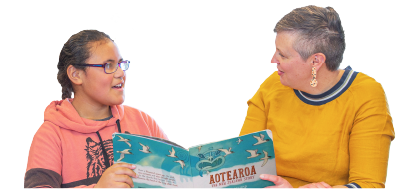Valuing Pacific culture
Show video transcript
Title slide: Valuing Pacific culture
Inside of Rev. Fitifiti Luatua’s house
Reverend Fitifiti Luatua, E.F.K.S Church, Christchurch
If you want to work with Pacific children you need to love them. The key is the person, the teacher, they need to love the children and they need to understand the children.
Reverend Fitifiti Luatua, E.F.K.S Church, Christchurch, facing camera
I remember being with the group that Tufulasi took to Samoa. I think they did the Pacific immersion in a village and one of the teachers was saying that that process that they did in merging with the cultures, living with the families and understanding how the children are brought up and how the family lives, eat and does their prayers. Everything that's connected with their life. That's when they started to understand, ‘Oh, they she she is health - had a different world altogether’. But it made - it allowed her to do her work well because that's when she had the heart for the - for the children. So I think that's first and foremost. They need to understand where the children come from.
Teachers with students in classrooms
They need to understand the family context. They need to understand the culture that, you know, provides a life to this yeah, to the children.
So when we talking about teachers and working with children from the Pacific, Asians, you name it; I think that's very important. You know you need to understand the cultural framework that provide that kind of understanding and the way they think and the way they do things.
Reverend Fitifiti Luatua, E.F.K.S Church, Christchurch, facing camera
Even with the dancings and all that...it is a lot of meaning in there. So, I think it's very important area to really look in if you really want to work with Pacific children and also with Asian children or whatever, where ever country they come from.
Crystal Tutapakore, Guidance Counsellor, Manurewa High School, Auckland, facing camera
I think listening more would be an awesome start. I know sometimes with our kids it's hard for them to feel confident, happy or proud to walk through doors, and that sometimes you know when they walk through the doors they've already got a label on them. So, just for our teachers to just, you know, not judge a book by its cover, just get to know the kids, cause when you break those barriers down, that's how we can engage more with our Pasifika especially our poly kids because they're pretty shy.
You know like in a new environment in unfamiliar territories, they're pretty shy, but when you break those barriers away they're pretty loud you know at the end of it. So yeah just listening, giving them time and space just to be them.
Pacific learners need to see their cultures in their classrooms. This video illustrates how schools should value Pacific cultures. Family context and culture are important components for Pacific learners. Valuing their identities, languages, and heritages is key for their educational success. Most Pacific learners are shy and not very confident about understanding who they are and where they come from, and the current system focuses primarily on achieving academic educational aspirations. The video challenges schools to work differently and reciprocally.
Reflections for individual teachers
Plan to get to know your Pacific learners and how you will integrate their language and culture into your classroom environment.
- Do you know your learners as individuals? Learners also want to know about you, and your life outside of school. Consider doing an activity based on personal storytelling. Share information about your own cultural identity and personal story. Encourage your learners to reciprocate. Share about your imperfections and times you have made mistakes. This will help your learners feel more comfortable about making mistakes and learning from them, and support strong relationships.
- Another activity to encourage and support your learners to appreciate and acknowledge their own cultural identity is to broaden your approach to food tasting, favourite songs, music and dance, learning a few Pacific words, or participating in an event that is meaningful to Pacific learners. Examples include participating in a wedding, a church service or a birthday celebration, or a community event like the market, a festival or another Pacific community activity.
- Explore culturally appropriate teaching approaches and resources with learners to try to meet their needs from a cultural perspective. Work together with your learners to identify important features for a culturally responsive curriculum. Have discussions with your learners and respond to their questions by giving feedback with relatable examples. Consider a buddy system for this activity to allow learners to support each other. Make connections to their culture and work with them to integrate ideas into classroom content.
Reflections for staff or departments
If you are a staff member or member of a department team, think of your own expectations of Pacific learners.
- Explore how your school is delivering for its Pacific learners. How is your school supporting Pacific learners to value their culture, home language, religion and values?
- How is your school supporting learners with English as a second language? What bilingual resources does your school provide? How do you use Pacific cultural activities as a learning context?
- Think about how your school develops teaching practice, and works on an inquiry framework, to examine classroom practices and identify strategies and approaches that make a difference for Pacific learners.

